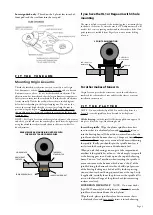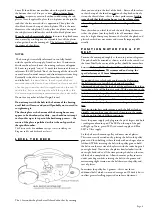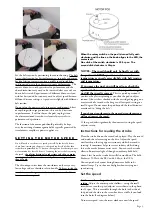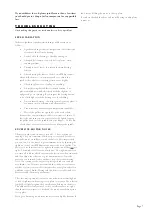
Page 7
If you withdraw the sub-platter spindle more than a few times
you should put in a drop of oil to compensate for any possible
loss.
T R O U B L E S H O O T I N G
Omit reading this greyed out section unless you have a problem
S P E E D VA R I AT I O N
If there is significant speed variation then possible causes are as
follows.
•
Significant changes in room temperature - this affects the
viscosity of the oil in the bearing.
•
Lack of oil in the bearing so check by adding oil.
•
Changed belt tension or an oily belt or platter - clean
running surfaces.
•
Turntable out of level – this affects the main bearing
friction.
•
After adjusting the tension of the 3 small Philips screws
which hold the motor on, you may need to re-adjust the
speed as they affect motor bearing friction very slightly.
•
Check the platter is not fouling on anything.
•
A dirty bearing that exhibits too much friction - The
platter should drift round effortlessly with the slightest of
nudges and go on spinning. If you suspect the bearing friction
to be a little high return the bearing to us for checking.
•
A worn thrust bearing - this may occur after many years of
continuous use in common with all turntables.
•
Transistors that have developed temperature instability.
• Most of the pulleys are a push fit on the motor shaft -
however they can sometimes work loose in transit or in use. If
this is the case then you can easily rectify it by lightly tapping
the pulley back onto the spindle with your fingers - Do not use
a hard object or excessive force as this can damage the spindle.
E X C E S S I V E M O T O R N O I S E
The motor needs a run in time of around 1 - 2 days continuous
running. They are sometimes a little noisy to start with. It is best to
run in the motor on full power with the belt off. Most importantly
you can “tune in” the motor to give minimum noise by adjusting the
tightness of the 3 small Phillips screws next to the motor pulley. The
best way to set their tension is to tighten the screws until they just nip
tight. Then back off all 3 screws a little way. Now tighten one screw
at a time till you hear which ones cause the least noise when tensioned
and then adjust the other two to give minimum noise. It may be
necessary to use thread lock or similar to stop the screws vibrating
loose. If it continues to be very noisy please get back to us and we
may check it out. However bear in mind that the dc motor is never
as silent as a/c motors are - this is because they are cogless and rely on
a different type of brush. Having said this dc motors still sound a lot
better in terms of musical performance.
The other major potential source of noise is the motor vibrating due
to lack of tightness and causing it’s top plate to resonate. The solution
is usually to slightly tighten the 3 small screws holding on the motor.
This adjustment is fairly critical - if the 3 small screws are too tight
then the motor whispers, too slack and the motor can vibrate against
it’s top plate.
If you get a knocking sound from the motor then slightly slacken off
the 3 screws holding the motor to the top plate.
If you have checked the above and are still having trouble please
contact us .


























